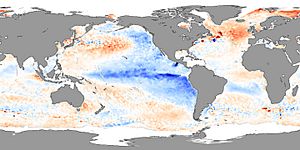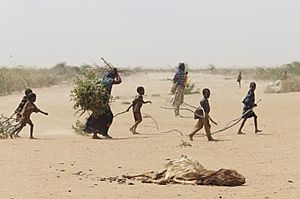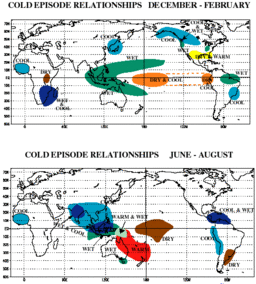La Niña facts for kids
La Niña is a natural event that happens when the ocean and atmosphere work together. It's like the opposite of El Niño. The name "La Niña" means "the little girl" in Spanish.
During La Niña, the waters in the eastern Pacific Ocean near the equator become cooler than usual. This change in ocean temperature affects weather patterns all over the world. For example, in the United States, the weather during La Niña years is often different from El Niño years. Also, the Atlantic hurricane season can have more powerful storms than normal.
Contents
Recent La Niña Events
La Niña events happen every few years. A strong La Niña occurred in 1988-1989. A weaker one followed in 1995.
From 1998 to 2000, there was a long period with strong La Niña conditions. After that, the weather returned to normal between 2000 and 2002. More recently, a La Niña happened in 2007-2008. The weather then went back to normal in 2008-2009.
How La Niña Affects Different Regions
La Niña events impact different parts of the world in various ways. The effects can also change depending on the season. While we expect certain things to happen during La Niña, it's not always guaranteed.
Africa
In Southern Africa, La Niña usually brings more rain than normal from December to February. But in East Africa, during the same time, it often causes drier conditions. For example, the Horn of Africa can experience droughts.
Asia
When La Niña is active, tropical cyclones (like typhoons) in the western Pacific Ocean tend to form further west. This means countries like China might face a higher risk of these storms hitting their coastlines.
In March 2008, a La Niña event caused sea surface temperatures in Southeast Asia to drop by about 2 degrees Celsius. It also led to very heavy rains in countries such as Malaysia, the Philippines, and Indonesia.
North America
La Niña often causes the opposite weather effects compared to El Niño.
- Rain and Snow: Areas like the northern Midwest, northern Rockies, Northern California, and parts of the Pacific Northwest usually get more rain and snow than average.
- Dry Conditions: Meanwhile, the southwestern and southeastern states, along with Southern California, often experience less rain than average.
- Hurricanes: La Niña can lead to more and stronger hurricanes in the Atlantic Ocean. At the same time, there are usually fewer hurricanes in the Pacific Ocean.
In Canada, La Niña generally brings cooler temperatures and more snow during winter. For example, the winter of 2007/2008 saw almost record-breaking amounts of snow in Eastern Canada due to La Niña.
South America
During La Niña, coastal areas of Peru and Chile often suffer from droughts. However, northern Brazil usually gets more rain than normal from December to February.
La Niña also causes very heavy rainfall in the central Andes mountains. This can lead to severe flooding in places like the Llanos de Mojos in Bolivia. Records show such floods happened many times, including in 1853, 1865, 1872, 1873, 1886, 1895, 1896, 1907, 1921, 1928, 1929, and 1931.
Images for kids
See also
 In Spanish: La Niña (fenómeno) para niños
In Spanish: La Niña (fenómeno) para niños




